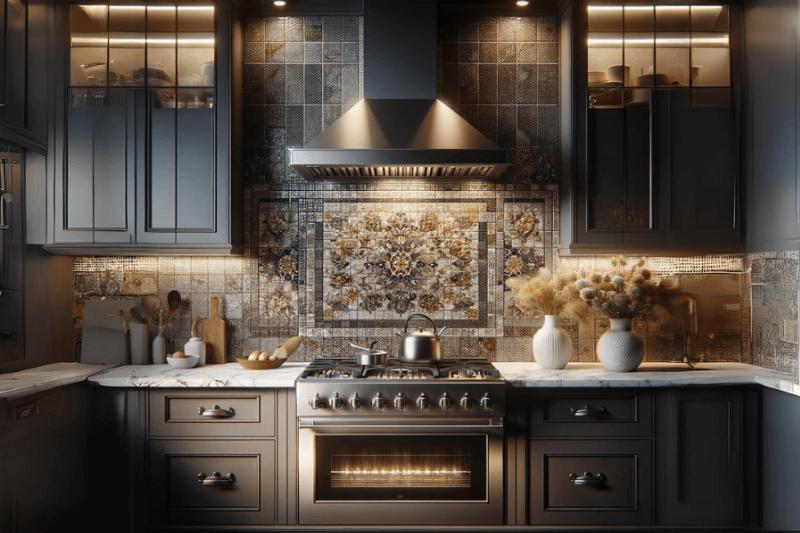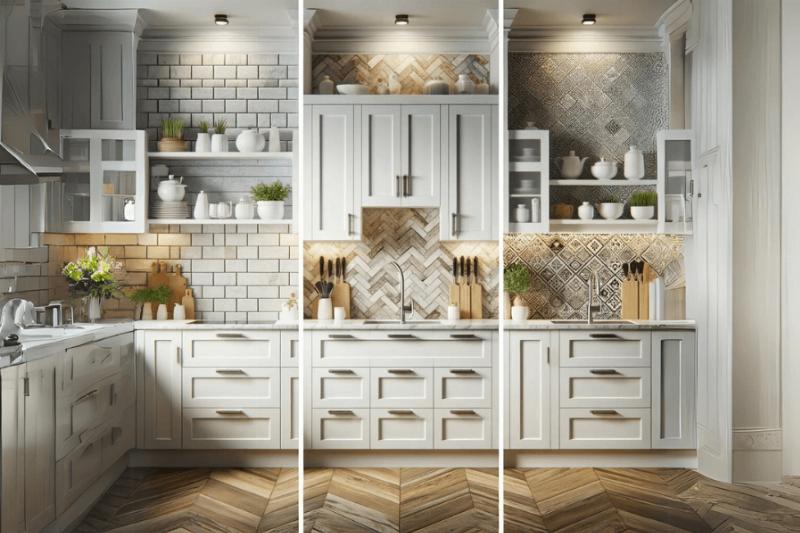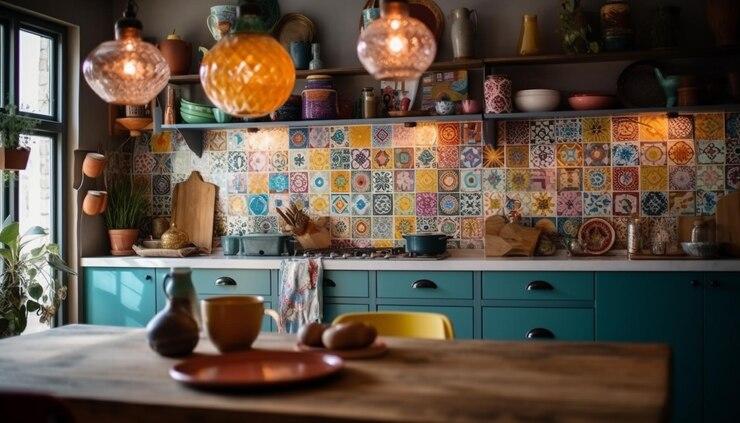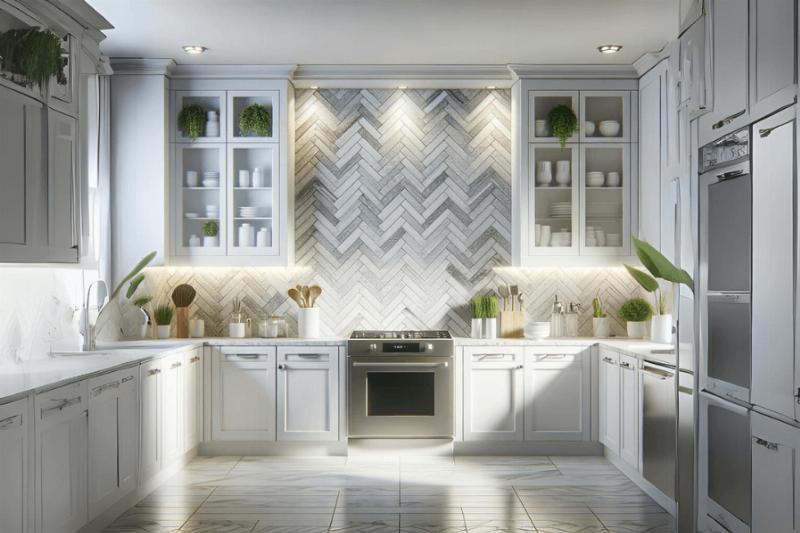Are you ready to breathe new life into your kitchen? Give it a new look. Consider adding a special backsplash for your white cabinets. A backsplash in the kitchen does more than protect the walls from the everyday wear and tear of cooking and food preparation. It can make your kitchen look amazing.
It’s a defining feature that sets the tone for the room, balancing utility and design. White cabinets are like a blank canvas that lets you be creative with your backsplash. You can use different textures, colours, and patterns to make your kitchen unique.
In this guide, we’ll look at how backsplashes make your kitchen with white cabinets both practical and stylish. They can blend in nicely or be a standout feature, depending on how you design them.
Why Backsplashes Matter in Kitchen Design

Backsplashes are essential in kitchen design not only for their protective qualities but also for their substantial impact on the kitchen’s overall look and feel. They offer a blend of practicality and aesthetic enhancement that serves multiple purposes in a well-designed kitchen.
1. Protection
First and foremost, a backsplash serves a practical purpose. It shields the walls behind countertops and ranges from spills, splatters, and stains that occur during everyday cooking and meal prep. This protective feature ensures the walls are easier to clean and maintain over time.
2. Aesthetic Appeal
Beyond function, a backsplash contributes significantly to the kitchen’s overall aesthetic. It can complement white cabinets with a consistent theme or introduce a contrasting style that turns the backsplash into a kitchen focal point. The color, material, and texture of the backsplash play pivotal roles in this visual dynamic.
3. Value Addition
An updated backsplash can also increase a home’s resale value. It’s one of the more noticeable aspects of a kitchen and can modernize an outdated space with a relatively small investment compared to other renovations.
Factors to Consider When Choosing a Backsplash for White Cabinets
Selecting the right backsplash for white cabinets is about balancing the need for a material that meets kitchen demands with the desire for a visually appealing and complementary design element. It’s important to weigh factors such as durability, maintenance, budget, and the overarching aesthetic of the kitchen.
1. Material Durability
Durability should be a top consideration since the kitchen is a high-traffic area. Materials should be resistant to heat, stains, and moisture to maintain their look and functionality for years to come.
2. Maintenance Requirements
Some backsplash materials are easier to clean than others, while some may be more prone to scratches or dents. The maintenance level you’re willing to commit to can steer your decision on the type of material to select.
3. Budget
Costs can vary widely based on the material chosen and the complexity of the installation. Budget considerations should include both the price of the materials and the labor to install the backsplash.
4. Overall Kitchen Aesthetic
The desired aesthetic of the kitchen should be consistent or complementary to the backsplash. Whether the aim is for a modern, traditional, or rustic vibe, the color palette and style will influence the final choice.
Top Backsplash Choices for White Cabinets

The ideal backsplash can significantly enhance the appearance of white cabinets. Let’s explore some of the best materials and styles that work well with white cabinets and serve different practical and style needs.
|
Backsplash Material |
Style |
Pros |
Cons |
|
Subway Tiles |
Classic |
Works with any design |
Limited design options |
|
Mosaic Tiles |
Textured |
Adds texture, color, and patterns |
Complex patterns |
|
Natural Stone |
Luxurious |
Natural patterns and veins |
Needs regular care |
|
Stainless Steel |
Industrial |
Durable and heat-resistant |
Visible the stains |
|
Wood or Wood-Look Tiles |
Warm, Rustic |
Handle moisture and heat |
Requires careful sealing |
1. Subway Tiles
Subway tiles are a timeless choice that pairs beautifully with white cabinets, offering a clean, classic look. They can brighten up a kitchen and are versatile enough to work with any design style. For a subtle look, white or neutral tiles are perfect, or you can opt for bolder colors to add a pop of interest.
2. Mosaic Tiles
Mosaic tiles bring texture and pattern to a kitchen and are a way to introduce color and personality into the space. They come in a wide array of materials, including glass, stone, and metal, allowing for unique combinations and designs that can act as artwork in the kitchen.
3. Natural Stone
Natural stones like marble, granite, or travertine can add a touch of luxury and timeless elegance to any kitchen. The natural patterns, veining, and color variations in these materials can complement white cabinets with their inherent beauty. They do require proper sealing and maintenance to keep them looking pristine.
4. Stainless Steel
For those leaning towards a modern or industrial look, stainless steel backsplashes can be an excellent choice. They’re durable, heat-resistant, and add a sleek, reflective quality to the kitchen. However, they can show water spots and fingerprints, requiring frequent cleaning to maintain their shine.
5. Wood or Wood-Look Tiles
Wood or wood-look tiles can add warmth and texture to a kitchen with white cabinets. They bring a rustic or farmhouse feel to the space and can be treated to resist moisture and heat. These backsplashes need to be carefully sealed and maintained to prevent damage from kitchen activity.
If you want to measure the backsplash tiles for your kitchen. Check out our article for a better understanding.
Color Theory & White Cabinets
Exploring the relationship between backsplash choices and white cabinetry through color theory can guide homeowners in creating the desired impact in their kitchen space. The right color scheme can either unify a room with subtle elegance or infuse it with dynamic visual interest, depending on the chosen palette.
1. Monochromatic Schemes
When pairing with white cabinets, a monochromatic color scheme utilizes various shades and tints of whites and neutrals. This approach creates a clean, unified look in the kitchen. It can make the space feel more open, serene, and expansive, as the subtle differences in whites and neutrals build upon each other without stark contrast.
2. Contrast & Pop
Introducing a bold colour or vibrant pattern can make a backsplash stand out against white cabinetry. This element of contrast adds visual depth and can serve as a focal point in the kitchen. A bright color or intricate pattern breaks the monotony and infuses the space with energy and personality.
3. Warm vs Cool Tones
The undertones in white cabinets—whether warm or cool—can significantly affect the overall aesthetic of the kitchen. It’s essential to understand these subtleties and choose a backsplash color that complements them. Warm undertones pair well with earthy hues, while cool-toned whites come alive next to blues and greens.
Installation Tips for a Seamless Look
Proper installation is crucial for achieving a professional and seamless finish for a kitchen backsplash. These tips can assist DIYers and professionals alike in ensuring the backsplash serves both its functional and aesthetic purposes effectively.
1. Preparation
Proper preparation is key to a successful backsplash installation. The wall surface should be cleaned, smoothed, and levelled. Plan your tile layout or pattern, considering the placement of outlets and appliances.
2. Adhesives & Grouting
Selecting the right adhesive is crucial for a long-lasting backsplash. Use grouting techniques that ensure clean lines and longevity of your backsplash. Pay attention to the manufacturer’s instructions for the best results.
3. Finishing Touches
Sealing natural stone backsplash is an important step to prevent stains and damage. Regular cleaning and proper maintenance can keep various materials looking their best and help prolong their life.
Current Trends in Kitchen Backsplashes

Trends in kitchen backsplashes reflect broader design movements and innovations, with current preferences showing a tilt toward materials that blend function and form while promoting sustainability.
1. Mixed Materials
Contemporary designs often feature mixed materials, such as metal inlays in stone backsplashes, creating layers of texture and visual interest. This trend invites a dynamic look that captures attention and personalizes the space.
2. Extended Backsplashes
Running the backsplash material up to the ceiling can significantly alter the room’s sense of space, often making the kitchen feel taller and more open. This design choice can also unify the space and give it a more finished look.
3. Eco-Friendly Materials
Sustainability has become increasingly important in kitchen design. Eco-friendly materials like recycled glass or sustainably sourced tiles not only minimize environmental impact but also offer unique and stylish options for the conscious homeowner.
Seek Help from An Expert – Smart Remodeling LLC
Do you need help regarding your revocation-consult us? At Smart Remodeling LLC, Our experts understand that a well-designed kitchen is the heart of your home. We’re a family-owned business and one of the best remodeling contractors in Houston.
For more than ten years, we’ve been helping our community with home, kitchen, and bathroom remodeling. We work with both homeowners and businesses. Contact us today for a quote and let Smart Remodeling LLC make your remodeling dreams come true.
Conclusion
The right backsplash can profoundly enhance the look and feel of a kitchen with white cabinets. When selecting a backsplash, it’s crucial to consider balancing personal style and functionality. With a thoughtful approach to colour theory, installation, and current trends, homeowners can create a kitchen that not only looks beautiful but also meets their practical needs and reflects their values.






